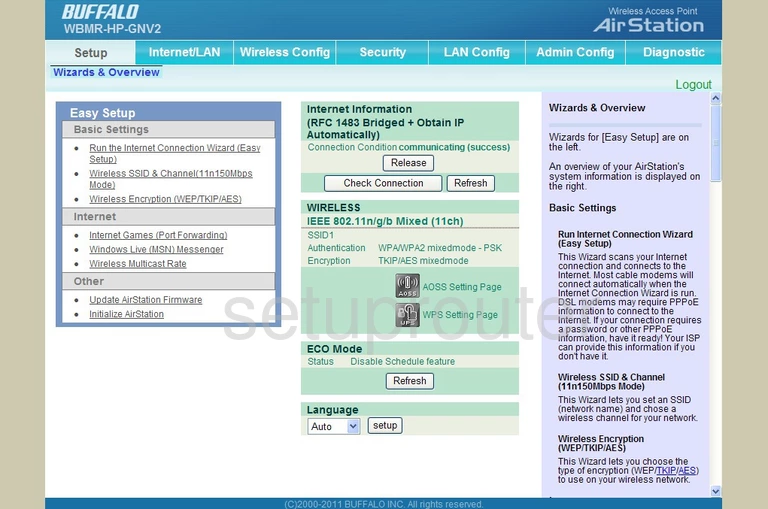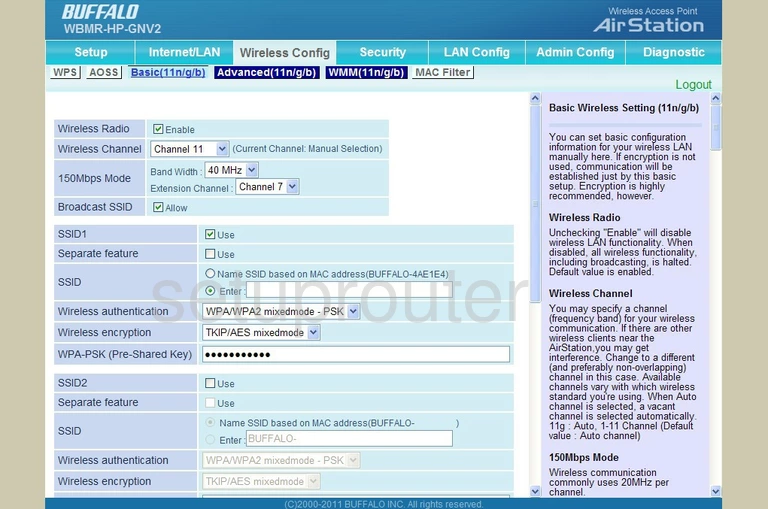The Buffalo WBMR-HP-GNV2 router is considered a wireless router because it offers WiFi connectivity. WiFi, or simply wireless, allows you to connect various devices to your router, such as wireless printers, smart televisions, and WiFi enabled smartphones.
Other Buffalo WBMR-HP-GNV2 Guides
This is the wifi guide for the Buffalo WBMR-HP-GNV2. We also have the following guides for the same router:
- Buffalo WBMR-HP-GNV2 - How to change the IP Address on a Buffalo WBMR-HP-GNV2 router
- Buffalo WBMR-HP-GNV2 - Buffalo WBMR-HP-GNV2 Login Instructions
- Buffalo WBMR-HP-GNV2 - Buffalo WBMR-HP-GNV2 User Manual
- Buffalo WBMR-HP-GNV2 - How to change the DNS settings on a Buffalo WBMR-HP-GNV2 router
- Buffalo WBMR-HP-GNV2 - How to Reset the Buffalo WBMR-HP-GNV2
- Buffalo WBMR-HP-GNV2 - Buffalo WBMR-HP-GNV2 Screenshots
- Buffalo WBMR-HP-GNV2 - Information About the Buffalo WBMR-HP-GNV2 Router
WiFi Terms
Before we get started there is a little bit of background info that you should be familiar with.
Wireless Name
Your wireless network needs to have a name to uniquely identify it from other wireless networks. If you are not sure what this means we have a guide explaining what a wireless name is that you can read for more information.
Wireless Password
An important part of securing your wireless network is choosing a strong password.
Wireless Channel
Picking a WiFi channel is not always a simple task. Be sure to read about WiFi channels before making the choice.
Encryption
You should almost definitely pick WPA2 for your networks encryption. If you are unsure, be sure to read our WEP vs WPA guide first.
Login To The Buffalo WBMR-HP-GNV2
To get started configuring the Buffalo WBMR-HP-GNV2 WiFi settings you need to login to your router. If you are already logged in you can skip this step.
To login to the Buffalo WBMR-HP-GNV2, follow our Buffalo WBMR-HP-GNV2 Login Guide.
Find the WiFi Settings on the Buffalo WBMR-HP-GNV2
If you followed our login guide above then you should see this screen.

This guide starts on the Home page of the Buffalo WBMR-HP-GNV2. To configure the WiFi settings, click the link at the top, in light blue. labeled Wireless Config. Then, below that pick the option of Basic (11n/g/b).
Change the WiFi Settings on the Buffalo WBMR-HP-GNV2

On this new page, the first thing that you need to check is the Wireless Channel. There is only room in the spectrum for up to three channels that don't overlap. Everyone should be using these channels if they have neighbors because overlap causes a lot of interference. Be sure that you use channel 1,6, or 11. For more on this topic, read our guide titled WiFi Channels.
Below that, find where it says SSID1. Go ahead and click the box that reads Use. Now find the SSID. This is the name you give your network so that you can identify it when needed. Tick the dot titled Enter and then enter the name you have chosen. Don't use personal information in this name. For more on this topic, read the guide titled Wireless names.
Next is the Wireless authentication. The most secure option here is WPA2-PSK. This is the type of security you are going to use. To learn about the differences in the security modes, read our guide titled WEP vs. WPA.
After that comes the Wireless encryption. How do you plan on encrypting your private data? The best choice is AES. Unfortunately I am unable to see the choices in this list. TKIP is a little older and has some flaws making it more vulnerable. AES is much stronger, and considered uncrackable right now.
The last thing you need to change is the WPA-PSK (Pre-Shared Key). This is a complicated way of saying password. This password is used to access the network and in the encryption technique. Be sure that this password is strong, use at least 20 characters, use some symbols, numbers, and capital letters. Don't use easily guessed information like addresses or names. Don't use words that can be found in a dictionary, these are cracked more easily due to programs containing dictionary words. To learn more, read our guide titled Choosing a strong password.
That's it, you've created a more secure WiFi network. Don't forget to click the Apply button before you exit.
Possible Problems when Changing your WiFi Settings
After making these changes to your router you will almost definitely have to reconnect any previously connected devices. This is usually done at the device itself and not at your computer.
Other Buffalo WBMR-HP-GNV2 Info
Don't forget about our other Buffalo WBMR-HP-GNV2 info that you might be interested in.
This is the wifi guide for the Buffalo WBMR-HP-GNV2. We also have the following guides for the same router:
- Buffalo WBMR-HP-GNV2 - How to change the IP Address on a Buffalo WBMR-HP-GNV2 router
- Buffalo WBMR-HP-GNV2 - Buffalo WBMR-HP-GNV2 Login Instructions
- Buffalo WBMR-HP-GNV2 - Buffalo WBMR-HP-GNV2 User Manual
- Buffalo WBMR-HP-GNV2 - How to change the DNS settings on a Buffalo WBMR-HP-GNV2 router
- Buffalo WBMR-HP-GNV2 - How to Reset the Buffalo WBMR-HP-GNV2
- Buffalo WBMR-HP-GNV2 - Buffalo WBMR-HP-GNV2 Screenshots
- Buffalo WBMR-HP-GNV2 - Information About the Buffalo WBMR-HP-GNV2 Router